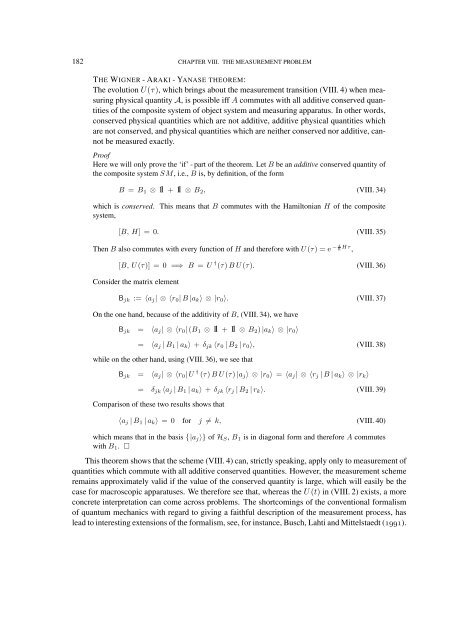FOUNDATIONS OF QUANTUM MECHANICS
FOUNDATIONS OF QUANTUM MECHANICS
FOUNDATIONS OF QUANTUM MECHANICS
Create successful ePaper yourself
Turn your PDF publications into a flip-book with our unique Google optimized e-Paper software.
182 CHAPTER VIII. THE MEASUREMENT PROBLEM<br />
THE WIGNER - ARAKI - YANASE THEOREM:<br />
The evolution U(τ), which brings about the measurement transition (VIII. 4) when measuring<br />
physical quantity A, is possible iff A commutes with all additive conserved quantities<br />
of the composite system of object system and measuring apparatus. In other words,<br />
conserved physical quantities which are not additive, additive physical quantities which<br />
are not conserved, and physical quantities which are neither conserved nor additive, cannot<br />
be measured exactly.<br />
Proof<br />
Here we will only prove the ‘if’ - part of the theorem. Let B be an additive conserved quantity of<br />
the composite system SM, i.e., B is, by definition, of the form<br />
B = B 1 ⊗ 11 + 11 ⊗ B 2 , (VIII. 34)<br />
which is conserved. This means that B commutes with the Hamiltonian H of the composite<br />
system,<br />
[B, H] = 0. (VIII. 35)<br />
Then B also commutes with every function of H and therefore with U (τ) = e − i H τ ,<br />
[B, U (τ)] = 0 =⇒ B = U † (τ) B U (τ). (VIII. 36)<br />
Consider the matrix element<br />
B jk := ⟨a j | ⊗ ⟨r 0 | B |a k ⟩ ⊗ |r 0 ⟩. (VIII. 37)<br />
On the one hand, because of the additivity of B, (VIII. 34), we have<br />
B jk = ⟨a j | ⊗ ⟨r 0 | (B 1 ⊗ 11 + 11 ⊗ B 2 ) |a k ⟩ ⊗ |r 0 ⟩<br />
= ⟨a j | B 1 | a k ⟩ + δ jk ⟨r 0 | B 2 | r 0 ⟩, (VIII. 38)<br />
while on the other hand, using (VIII. 36), we see that<br />
B jk = ⟨a j | ⊗ ⟨r 0 | U † (τ) B U (τ) |a j ⟩ ⊗ |r 0 ⟩ = ⟨a j | ⊗ ⟨r j | B | a k ⟩ ⊗ |r k ⟩<br />
= δ jk ⟨a j | B 1 | a k ⟩ + δ jk ⟨r j | B 2 | r k ⟩. (VIII. 39)<br />
Comparison of these two results shows that<br />
⟨a j | B 1 | a k ⟩ = 0 for j ≠ k, (VIII. 40)<br />
which means that in the basis {|a j ⟩} of H S , B 1 is in diagonal form and therefore A commutes<br />
with B 1 . □<br />
This theorem shows that the scheme (VIII. 4) can, strictly speaking, apply only to measurement of<br />
quantities which commute with all additive conserved quantities. However, the measurement scheme<br />
remains approximately valid if the value of the conserved quantity is large, which will easily be the<br />
case for macroscopic apparatuses. We therefore see that, whereas the U (t) in (VIII. 2) exists, a more<br />
concrete interpretation can come across problems. The shortcomings of the conventional formalism<br />
of quantum mechanics with regard to giving a faithful description of the measurement process, has<br />
lead to interesting extensions of the formalism, see, for instance, Busch, Lahti and Mittelstaedt (1991).
















